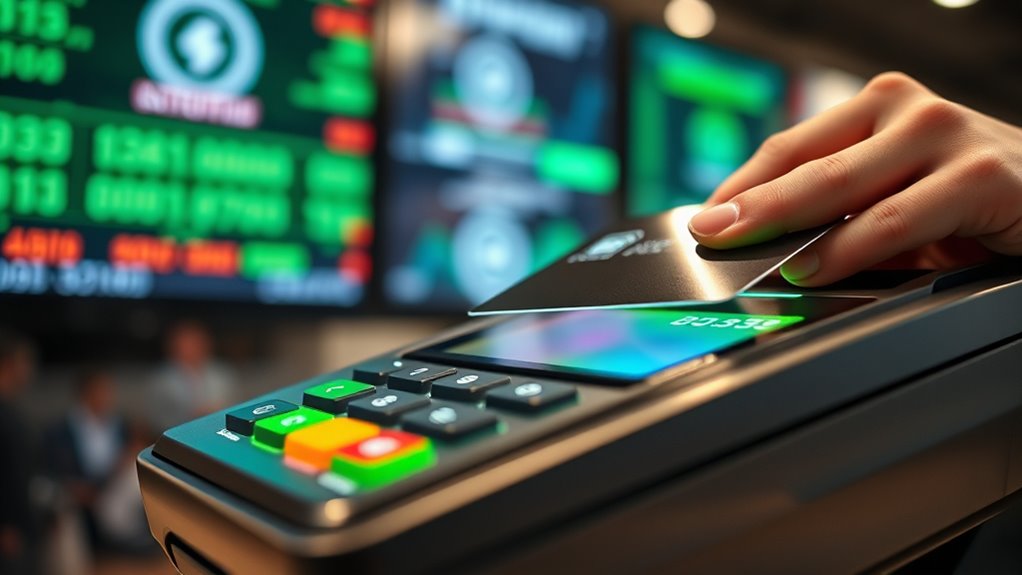When you make a card payment, your card details are quickly sent through secure networks to the merchant’s bank and the card network, like Visa or MasterCard. The request is then routed to your issuing bank, which checks your account for funds and fraud. Once approved, the transaction moves swiftly through clearing and settlement, transferring funds minus fees from your account to the merchant’s. If you want to understand each step more closely, there’s much more behind the scenes to explore.
Key Takeaways
- The transaction starts instantly when a card is swiped, tapped, inserted, or manually entered into the payment system.
- The payment data is securely routed through networks to the issuing bank for authorization.
- The bank verifies credit, legitimacy, and runs fraud checks before approving or declining the transaction.
- Approved transactions are batched, cleared, and settled, transferring funds from the cardholder to the merchant.
- Multiple entities collaborate to ensure secure, efficient fund transfer, deducting fees before finalizing the payment.

Have you ever wondered what happens behind the scenes when you swipe or tap your credit card? When you initiate a payment, the process begins almost instantly, involving several key stages. First, you submit your payment by swiping, tapping, inserting the chip, or entering your details manually. This step sends your transaction request to the merchant’s payment system, which then passes it along to a payment processor. The processor acts as the middleman, organizing and batching transactions for further steps.
Next comes authorization. Your payment data, including your card details and the purchase amount, is forwarded through a secure network to the acquiring bank—the merchant’s bank—and then on to the card network, such as Visa or MasterCard. The card network routes this request to your issuing bank, which issued the credit card you’re using. The issuing bank performs checks to confirm your account has enough available credit and that your card is legitimate. It also runs preliminary fraud and credit checks. If everything checks out, the bank sends back an approval, placing a temporary hold on your funds, but no money is yet transferred. If there’s an issue—insufficient credit or suspected fraud—the bank declines the request, and the transaction stops here.
Authentication is the next crucial step. It verifies that the card and transaction details are legitimate, helping prevent fraud. Your bank and the merchant’s bank verify data consistency and may require additional security measures, such as 3-D Secure, which asks for extra authentication. Only after passing this stage does the transaction get approved, and the funds are temporarily held, signaling to the merchant that payment is secured. Authentication adds an extra layer of security to protect both the merchant and the cardholder from potential fraud. Additionally, bank identifiers like SWIFT/BIC codes are used in the background to facilitate secure and accurate communication between banks across borders.
Once authorized, the process moves into clearing. Merchants group authorized transactions into batches and send them to payment processors, who relay the data through card networks to the respective issuing banks. This batching usually happens once a day or at scheduled intervals, streamlining the process for efficiency. Clearing prepares the transaction data for settlement, ensuring all parties agree on the details.
Finally, settlement occurs. The issuing bank transfers the funds—minus interchange fees, assessment charges, and processing costs—to the merchant’s bank via the card network. The merchant’s bank then credits the merchant’s account, completing the cycle. This transfer typically takes 24 to 48 hours but can take longer depending on banks and networks. Throughout this process, various participants work together seamlessly—your cardholder account, merchant, payment gateway, processor, and card networks—making sure your purchase ends with funds moving securely and efficiently from your account to the merchant’s.
Frequently Asked Questions
How Long Does a Typical Card Transaction Take to Complete?
A typical card transaction takes about 1 to 3 business days to complete. You’ll see the authorization happen within seconds, but the settlement process, where funds transfer to the merchant, usually takes a day or two. Factors like weekends, holidays, or your bank’s processing speed can affect this timeline. Using faster payment methods or same-day settlement options can help get your transaction completed more quickly.
What Security Measures Protect Cardholder Data During Processing?
You want to know how your card data stays safe during processing. Encryption shields your information during transmission and storage, making it unreadable to hackers. Authentication verifies your identity, preventing unauthorized use. Fraud detection tools analyze transactions for suspicious activity, while tokenization replaces sensitive data with useless tokens. Together, these security measures—encryption, authentication, and fraud prevention—work seamlessly to protect your cardholder data from theft and misuse.
How Do Chargebacks Affect Merchants’ Payment Processing?
Chargebacks impact your payment processing by increasing costs and straining resources. When disputes happen, you face fees, lost revenue, and operational disruptions. Many chargebacks are hard to win, especially with high friendly fraud rates. They also lead to higher processing fees and potential reputational damage. To minimize these effects, you need proactive strategies like early alerts and fraud detection tools, which can substantially reduce chargeback volume and protect your bottom line.
What Role Do Payment Gateways Play in Transactions?
Did you know that 83% of online shoppers abandon their carts due to security concerns? Payment gateways play a vital role by encrypting your sensitive info, verifying transactions with banks, and ensuring smooth, secure transfers. They act as a bridge between your device and the payment processor, supporting global transactions and protecting data. Without them, your online payments wouldn’t be safe or seamless, making your shopping experience trustworthy and efficient.
Are There Fees Associated With Failed or Declined Transactions?
You should know that fees are definitely involved with failed or declined transactions. When a payment gets rejected, your bank or payment partner often charges around $12 on average. These fees can add up quickly, especially with cross-border or recurring payments, increasing your operational costs. Managing and preventing these failures through better validation and automation helps you cut down on unnecessary fees and improves your overall transaction success rate.
Conclusion
Now you know what happens behind the scenes of a card transaction—it’s like a well-choreographed dance, seamless and precise. Each step, from swiping your card to the bank’s approval, works together to keep your payments secure and instant. Next time you tap or swipe, remember the complex journey happening in the blink of an eye. It’s a silent hero, making your everyday purchases smooth as a gentle breeze.









